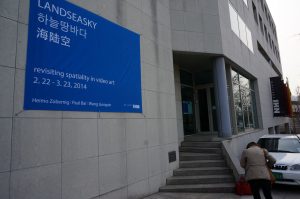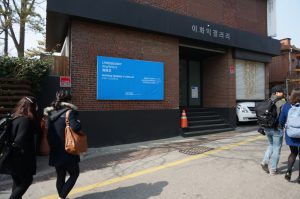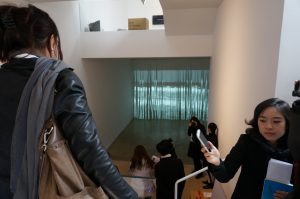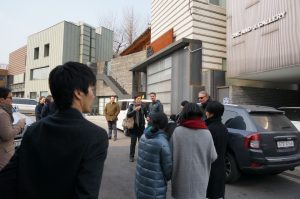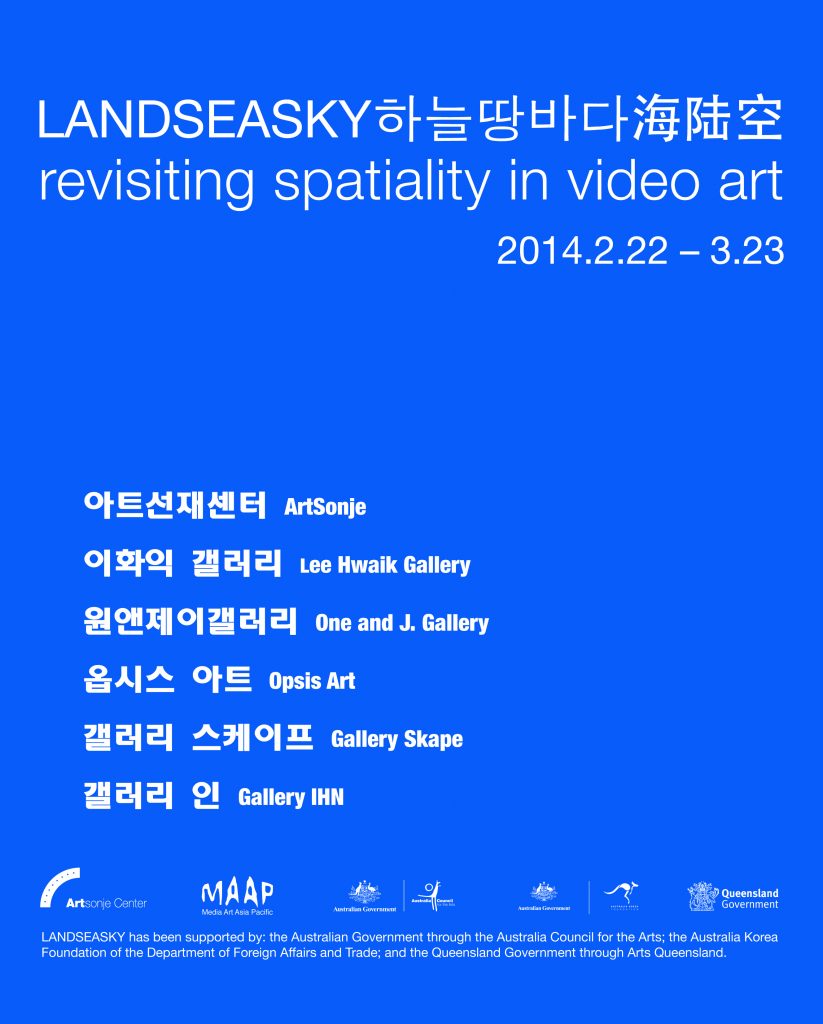LANDSEASKY: revisiting spatiality in video art brings visually rich and challenging video artworks from 17 international contemporary artists to 3 countries, 5 cities, activating 11 venues in a major Asia – Australia tour. The exhibition was presented in South Korea, China and Australia across multiple prestigious museums and galleries in 2014 – 2015, and including Artsonje Center (Seoul), OCT- Contemporary Art Terminal (Shanghai), Guangdong Museum of Art (Guangzhou), Griffith University Art Gallery and MAAP SPACE (Brisbane), The National Art School Gallery (Sydney) along with five commercial galleries in Seoul – ONE AND J Gallery, Gallery IHN, Gallery Skape, Lee Hwaik Gallery and Opsis Art.
This internationally touring exhibition speaks to the three elements represented by the horizon line as an emblematic starting point to investigate spatiality in video and the moving image. The sculptural attributes of video and the moving image are brought to the fore to address the elemental theme of the exhibition in a phenomenological rather than narrative experience.
Carrying the hallmarks of MAAP’s unique approach to cross-cultural exchange, artists from Australia, Asia and Europe are brought together in a conversation around a shared theme. New artworks created for the exhibition are in dialogue with early works by influential Dutch Conceptual artist Jan Dibbets. Dibbets is one of the early pioneers to use the camera as a contemporary art medium, and so too in film. LANDSEASKY commences with the complete 1971 Horizon-Sea series by Dibbets: Horizon-Sea I, Horizon-Sea II, and Horizon-Sea III. Originally created on 32 and16 millimetre film, now transferred to digital media, the seven screen (diptych, triptych,diptych) is shown together for the first time.
The exhibition is presented in new configurations in each country of the tour. In its first destination, Seoul, the artworks spanned across six venues – a combination of some of South Korea’s leading art museums and commercial galleries. Audiences walk between the galleries all located within a five minutes walking journey where major contemporary museum Art Sonje Center forms the anchor point of the exhibition with a display of Jan Dibbets’ seminal work. The walk between the six galleries in Seoul provides a spatial pause to consider each individual gallery’s exhibition and simultaneously, the accumulative LANDSEASKY exhibition within the Samcheong-dong district.
Other participating venues as part of the tour include OCT-OCAT Contemporary Art Terminal, Shanghai, Griffith University Art Gallery in Brisbane and the National Art School Gallery in Sydney. The exhibition is partnered with a number of Asian and Australian organisations including the Queensland University of Technology and the QUT Confucius Institute.
Dates & Venues:
Seoul, Korea21 February – 23 March 2014
Venues: Artsonje Center, Lee Hwaik Gallery, One and J Gallery, Opsis Art, Gallery IHN, Gallery Skape
Shanghai, China 20 April – 22 June 2014
Venue: OCT – OCAT Contemporary Art Terminal, Shanghai
Sydney, Australia 21 August – 11 October 2014
Venue: National Art School Gallery
Brisbane, Australia1 October – 13 November 2014
Venue: Griffith University Art Gallery
1 October – 28 November 2014
Venue: MAAP SPACE Gallery
Guangzhou, China 26 March to 6 May 2015
Venue: Guangdong Museum of Art, Guangzhou
For more information on each artist and artwork included in LANDSEASKY, please click the names below:
Artists include: Jan Dibbets (The Netherlands), Paul Bai (Australia), Lauren Brincat (Australia), Barbara Campbell (Australia), Wang Gongxin (China), Shilpa Gupta (India), Yeondoo Jung (South Korea), Derek Kreckler (Australia), Giovanni Ozzola (Italy), Joao Vasco Paiva (Portugal/Hong Kong), Wang Peng (China), Kimsooja (South Korea), Craig Walsh (Australia), Sim Cheol Woong (South Korea), Heimo Zobernig (Austria), Yang Zhenzhong (China), Zhu Jia (China)
Major Sponsors | Australia Council for the Arts | Arts Queensland | Australia- Korea Foundation
Thanks to the Australian Embassy, Seoul and Australian Embassy, Beijing.
Click on the Exhibition Catalogue or Invite below for more details on each artist & gallery participating in LANDSEASKY Seoul:
Exhibition Documentation:
Installation View:




